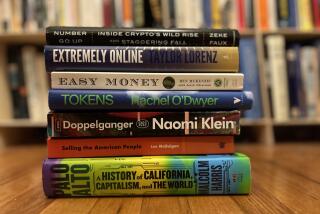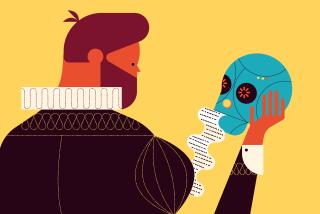Paper or Plastic
When I received word I would be reviewing “Scrolling Forward,” I went to my local bookstore to pick up a copy. I had forgotten the title. I asked at the information desk about the book, which had been on the New Science and Technology table the previous weekend, had orange and blue on the cover and was about documents.
The people at the information desk couldn’t remember the title either, but they remembered the book and knew the most likely place where half a dozen copies had been moved. So despite not knowing the author or title, we found it in a matter of seconds.
Drawing on knowledge of a book’s recent location, jacket design, general subject and the way books circulate between display tables and shelves to find a particular volume may seem disorganized and baroque. It is, but it’s how most of us work. Our complicated relationship with documents--everything from Post-Its to encyclopedias--is the subject of David Levy’s “Scrolling Forward: Making Sense of Documents in the Digital Age.”
Levy, a doctoral computer scientist and calligrapher, is well placed to compare the old and new. His book is organized around broad subjects--reading, writing and the like--but each chapter is a meditation, written more on the “this reminds me of that” principle, than according to something more formal. Such an approach can occasionally get out of control, but at its best the book’s style effectively juxtaposes printed and electronic documents and calculates the gains and losses of moving information from one medium to the other.
The fact that Levy is interested in this question indicates a growing maturity in our attitudes toward digital materials. A decade ago, the first important works on hypertext and multimedia--George P. Landow’s “Hypertext” and Jay David Bolter’s “Writing Space”--declared that, thanks to the computer, the author was dead, the reader reigned supreme, the book was doomed and linear thinking was passe.
They were widely praised within academic circles and provoked defenders such as Sven Birkerts to assert the eternal value of the book. The debate that has followed has largely been beside the point, because it misses several things that Levy wisely considers in depth.
First, arguments over “the future of the book” focus on books, particularly high literature. But we live in a world saturated with texts: We might not read Dante every today, but we’ll read street signs, scan newspapers, select from restaurant menus, answer e-mail, ignore ads, type URLs.
To drive the point home, “Scrolling Forward” begins not with a discussion of encyclopedias or the Bible, but with a deli receipt. Even something so utterly inconsequential turns out to draw upon thousands of years of history and complex social institutions, not to mention a host of technologies.
“Over the centuries a complex network of institutions and practices has grown up to create and maintain meaningful and reliable paper documents,” Levy argues. This is as true of receipts as it is of Rilke: “To be a receipt is to be connected to cash registers, sellers, buyers, products, expense reports, the IRS, and so on.” It takes a village to make a document.
Levy’s receipt was a hybrid, a printed record generated by an electronic system; therein lies a second big point. It turns out that documents have sloshed between electronic and printed form for decades. Checks and airline tickets were computer-printed from the 1950s. Mainframe computer publishing systems were developed in the 1960s and 1970s for newspapers and other high-volume publishers. (It is instructive that the early adopters weren’t book publishers but companies that had high-volume, varied or rapidly changing material. The Encyclopaedia Britannica’s publishing system was adapted from one developed for the Jehovah’s Witnesses, who publish countless pamphlets in dozens of languages.) In the 1980s, word processors allowed writers to create digital texts. In the 1990s, Web browsers gave readers direct access to digital works. This last and most-publicized step was a culmination, not a revolution. Seen in this light, the whole print versus digital debate seems irrelevant.
The fact that the debate over “the future of the book” took off in the last decade suggests that what’s at stake isn’t just materials but practices and cultural institutions. We pick up cues about the utility and reputability of printed sources from the publisher, the feel of the paper, even from a document’s location in a library or bookstore; such cues have yet to be reproduced consistently online, and the social networks that add value to printed works weren’t threatened by the computerization of typesetting and printing.
Documents, Levy argues, aren’t just information; they’re also material things and cultural artifacts. Even digital documents aren’t “just” immaterial bits. As Levy notes, “the ones and zeros of our digital representations ... are embedded in a material substrate no less than are calligraphic letter forms on a piece of vellum.”
This is not to say that an electronic document can’t have all the qualities of a printed one. It is to say, however, that those qualities can’t be programmed as features in the next upgrade: They have to be created in the social world and in the world of human practices and attitudes. Levy wants us to recognize that books and journals are much more than containers from which content can now be “liberated.” They have influenced-- often to the good--the way we read, organize our thoughts and create order in our intellectual worlds.
More to Read
Sign up for our Book Club newsletter
Get the latest news, events and more from the Los Angeles Times Book Club, and help us get L.A. reading and talking.
You may occasionally receive promotional content from the Los Angeles Times.





